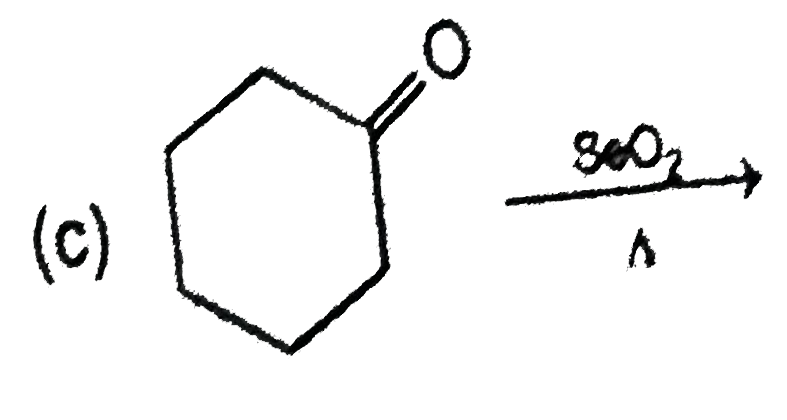In the reaction
Intermediate formed is :
carbocation
carbanion
free radical
No intermediate formed
The correct Answer is:B
To solve the question regarding the intermediate formed in the reaction of CF3−CHCl2 with LDA, we will follow these steps:
Step 1: Identify the Reactants and Conditions
The reactant is CF3−CHCl2, and it is treated with LDA (Lithium Diethyl Amine), which is a strong base.
Hint: Recognize the role of LDA as a strong base that can facilitate elimination reactions.
Step 2: Analyze the Type of Reaction
The formation of CF2=Cl2 indicates that an elimination reaction is taking place. In elimination reactions, we typically remove a leaving group and a hydrogen atom to form a double bond.
Hint: Look for the products to determine the type of reaction occurring (elimination in this case).
Step 3: Determine the Elimination Mechanism
There are three types of elimination mechanisms: E1, E2, and E1CB. Since LDA is a strong base, it is unlikely to follow the E1 mechanism, which typically involves carbocation formation.
Hint: Recall that E2 mechanisms do not form intermediates, while E1CB mechanisms do.
Step 4: Eliminate E2 Mechanism
In E2 elimination, no intermediate is formed; only a transition state exists. Since we are looking for an intermediate, we can rule out the E2 mechanism.
Hint: Remember that E2 reactions proceed in a single step without intermediates.
Step 5: Confirm E1CB Mechanism
Given that E2 is ruled out, the remaining possibility is the E1CB mechanism, which involves the formation of a carbanion intermediate. The presence of an electron-withdrawing group (CF3) supports the formation of a carbanion.
Hint: Identify the role of electron-withdrawing groups in facilitating the E1CB mechanism.
Step 6: Formation of the Carbanion
In the E1CB mechanism, the strong base (LDA) abstracts a proton (H) from the carbon adjacent to the leaving group (Cl), resulting in the formation of a carbanion (CF3−Cl2−).
Hint: Visualize the process of proton abstraction leading to carbanion formation.
Step 7: Finalize the Product
After the carbanion is formed, the negative charge can shift, leading to the formation of the double bond and the final product CF2=Cl2.
Hint: Understand how charge rearrangement leads to the final product in elimination reactions.
Conclusion
The intermediate formed in the reaction is a carbanion.
Final Answer: The intermediate formed is a carbanion.
The reactant is CF3−CHCl2, and it is treated with LDA (Lithium Diethyl Amine), which is a strong base.
The formation of CF2=Cl2 indicates that an elimination reaction is taking place. In elimination reactions, we typically remove a leaving group and a hydrogen atom to form a double bond.
There are three types of elimination mechanisms: E1, E2, and E1CB. Since LDA is a strong base, it is unlikely to follow the E1 mechanism, which typically involves carbocation formation.
In E2 elimination, no intermediate is formed; only a transition state exists. Since we are looking for an intermediate, we can rule out the E2 mechanism.
Given that E2 is ruled out, the remaining possibility is the E1CB mechanism, which involves the formation of a carbanion intermediate. The presence of an electron-withdrawing group (CF3) supports the formation of a carbanion.
In the E1CB mechanism, the strong base (LDA) abstracts a proton (H) from the carbon adjacent to the leaving group (Cl), resulting in the formation of a carbanion (CF3−Cl2−).
After the carbanion is formed, the negative charge can shift, leading to the formation of the double bond and the final product CF2=Cl2.
The intermediate formed in the reaction is a carbanion.
Similar Questions
Knowledge Check
F2C=CF2 is a monomer of
AteflonBglyptalCnylon-6Dbuna-SThe intermediates formed during the reaction :
C6H5CH2COOAg+Br2CCl4−−→ΔC6H5CH2BrA BC6H5.CH2CBr∗D
BC6H5.CH2CBr∗D
CH3−CH2−CH2−CH3AlCl3−−−−−→ΔCH3−CH∣CH3−CH3
Above reaction is an example of :AisomerizationBpolymerizationCcrackingDde-hydrogenation
CF2=CF2 is a monomer of
View SolutionIn the following reaction sequence Y is,
PhOCOCH3AlCl3−−→Δ(X)I2−−−→NaOH(Y)
View SolutionComplete the following
(a) CH3−CHOSeO2−−→Δ, (b) H3C−CH2−O∣∣C−CH3SeO2−−→Δ, (c)
View SolutionIn the following reaction C is, CH3−CH=CH2+ HCl
Organic−−−−−−→PeroxideAAg2O−−−−−→MoistBEt MgBr−−−−→C
View SolutionWhich of the statements are correct about the reaction ?
 (A) H⊕−−→Δ (B) H2O⊕−−−→ (C ) Δ−−→ (D)
(A) H⊕−−→Δ (B) H2O⊕−−−→ (C ) Δ−−→ (D)
View Solution